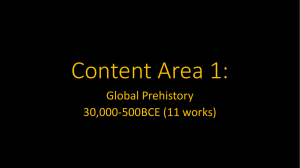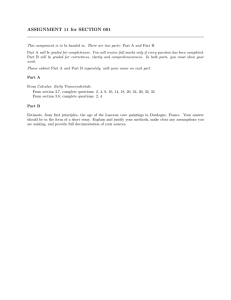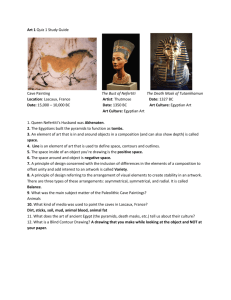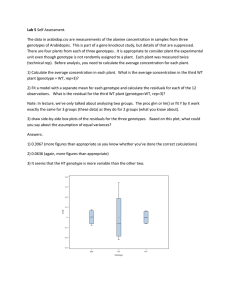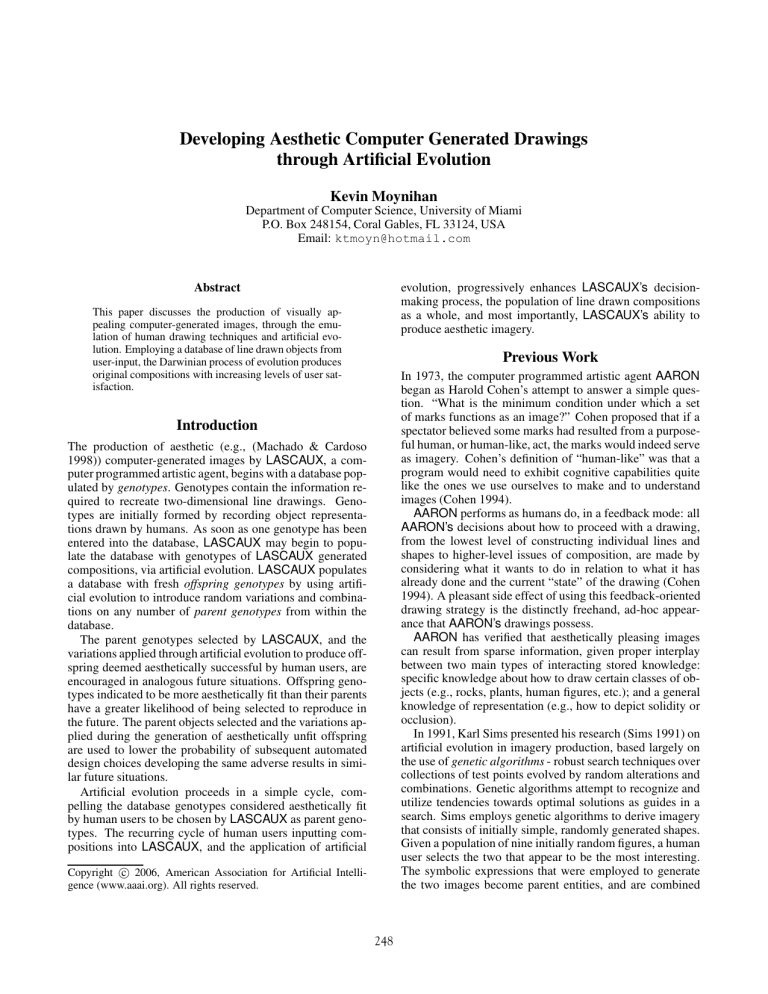
Developing Aesthetic Computer Generated Drawings
through Artificial Evolution
Kevin Moynihan
Department of Computer Science, University of Miami
P.O. Box 248154, Coral Gables, FL 33124, USA
Email: ktmoyn@hotmail.com
evolution, progressively enhances LASCAUX’s decisionmaking process, the population of line drawn compositions
as a whole, and most importantly, LASCAUX’s ability to
produce aesthetic imagery.
Abstract
This paper discusses the production of visually appealing computer-generated images, through the emulation of human drawing techniques and artificial evolution. Employing a database of line drawn objects from
user-input, the Darwinian process of evolution produces
original compositions with increasing levels of user satisfaction.
Previous Work
In 1973, the computer programmed artistic agent AARON
began as Harold Cohen’s attempt to answer a simple question. “What is the minimum condition under which a set
of marks functions as an image?” Cohen proposed that if a
spectator believed some marks had resulted from a purposeful human, or human-like, act, the marks would indeed serve
as imagery. Cohen’s definition of “human-like” was that a
program would need to exhibit cognitive capabilities quite
like the ones we use ourselves to make and to understand
images (Cohen 1994).
AARON performs as humans do, in a feedback mode: all
AARON’s decisions about how to proceed with a drawing,
from the lowest level of constructing individual lines and
shapes to higher-level issues of composition, are made by
considering what it wants to do in relation to what it has
already done and the current “state” of the drawing (Cohen
1994). A pleasant side effect of using this feedback-oriented
drawing strategy is the distinctly freehand, ad-hoc appearance that AARON’s drawings possess.
AARON has verified that aesthetically pleasing images
can result from sparse information, given proper interplay
between two main types of interacting stored knowledge:
specific knowledge about how to draw certain classes of objects (e.g., rocks, plants, human figures, etc.); and a general
knowledge of representation (e.g., how to depict solidity or
occlusion).
In 1991, Karl Sims presented his research (Sims 1991) on
artificial evolution in imagery production, based largely on
the use of genetic algorithms - robust search techniques over
collections of test points evolved by random alterations and
combinations. Genetic algorithms attempt to recognize and
utilize tendencies towards optimal solutions as guides in a
search. Sims employs genetic algorithms to derive imagery
that consists of initially simple, randomly generated shapes.
Given a population of nine initially random figures, a human
user selects the two that appear to be the most interesting.
The symbolic expressions that were employed to generate
the two images become parent entities, and are combined
Introduction
The production of aesthetic (e.g., (Machado & Cardoso
1998)) computer-generated images by LASCAUX, a computer programmed artistic agent, begins with a database populated by genotypes. Genotypes contain the information required to recreate two-dimensional line drawings. Genotypes are initially formed by recording object representations drawn by humans. As soon as one genotype has been
entered into the database, LASCAUX may begin to populate the database with genotypes of LASCAUX generated
compositions, via artificial evolution. LASCAUX populates
a database with fresh offspring genotypes by using artificial evolution to introduce random variations and combinations on any number of parent genotypes from within the
database.
The parent genotypes selected by LASCAUX, and the
variations applied through artificial evolution to produce offspring deemed aesthetically successful by human users, are
encouraged in analogous future situations. Offspring genotypes indicated to be more aesthetically fit than their parents
have a greater likelihood of being selected to reproduce in
the future. The parent objects selected and the variations applied during the generation of aesthetically unfit offspring
are used to lower the probability of subsequent automated
design choices developing the same adverse results in similar future situations.
Artificial evolution proceeds in a simple cycle, compelling the database genotypes considered aesthetically fit
by human users to be chosen by LASCAUX as parent genotypes. The recurring cycle of human users inputting compositions into LASCAUX, and the application of artificial
Copyright c 2006, American Association for Artificial Intelligence (www.aaai.org). All rights reserved.
248
variation by recombination and mutation must be incorporated into the new genotypes. Mutation is accomplished
with a mutation operator that selects a node within a genotype, and randomly changes its contents. In most cases,
only a slight modification of genotype expressions is encouraged. Small mutations over long periods of time have
a much greater chance of being eliminated if deemed unfit.
Large random mutations in genotype expressions usually result in large jumps in phenotype that are less likely to be
improvements, due to the unguided nature of the alteration.
numerous times in various ways to produce a subsequent
population of nine new images displaying attributes of both
parent images. From this new population of offspring images, two parent images are selected and the cycle continues. Through this iterated process of interactive selection,
the images are advanced under the guidance of the human
user to a level considered aesthetically pleasing.
In Sims’ system, the user must remain an active participant throughout the entire evolution, continuously selecting two images to be the parents of the subsequent generation’s population. However, Sims has demonstrated artificial
evolution to be a potentially powerful tool for the creation
of procedurally generated structures, textures, and motions.
Reproduction with random variations and survival of the visually interesting can lead to useful results.
LASCAUX
Overall Algorithm and Process
LASCAUX operates in two basic modes, an input mode with
evaluation, and an output mode with evaluation. In input
mode, LASCAUX offers a drawing canvas and four primitives to develop compositions. The canvas is a window on
the screen. A primitive is a basic two-dimensional shape.
LASCAUX’s four primitives are (i) a rectangle, (ii) a circle, (iii) a polyline (an open form comprised of connected
line segments, i.e. the first endpoint of the first line segment does not have to be the final endpoint of the final line
segment), and (iv) a polygon (a closed form comprised of
connected line segments, i.e. the first endpoint of the first
line segment is always the final endpoint of the final line
segment). A composition is a tree of objects. The root of
the tree is the top-level object. An object contains primitives
and/or sub-objects. One composition is stored as one genotype entry within LASCAUX’s database in the guidance
file. A composition’s genotype stores the information necessary to render the composition. The (sub-)objects within
a composition have corresponding (sub-)genotypes within
the composition’s genotype. Any object (or sub-object) can
be extracted from a guidance file genotype and used as a
new genotype. Each genotype in LASCAUX’s guidance file
contains a top-level composition title, an overall compositional rating, each object’s title in the composition, a selection method for each object in the composition, and an object
specific rating for each sub-object. Each part of a genotype
is described below.
Artificial Evolution
Artificial evolution (Sims 1991) could be considered a system for helping a human user with creative explorations, or
it might be considered as a system that attempts to “learn”
about human aesthetics from a human user. In either case, it
allows a user and a computer to interactively work together
and produce results that neither could easily produce alone.
Bringing the expertise of art and technology together has
usually been the achievement of one person working alone.
As we consider more recent digital art, increasing collaboration occurs between people from different disciplines with
different skills. The paradigm for digital art seems to be
shifting toward collaborative practice as a norm (Edmonds
& Candy 2002).
Analogous to the field of biology, artificial evolution includes the basic concepts of genotype and phenotype, as well
as the processes of selection and variant reproduction. The
genotype is the genetic makeup of an individual. In biological systems, genotypes are strands of DNA, whilst in
artificial evolution, genotypes are represented in numerous
ways, e.g., strings of binary digits, sets of procedural parameters, or symbolic expressions. The phenotype is the form
that results from a set of specialized situational developmental rules and a genotype. In LASCAUX, the phenotype is
a composition generated from a genotype in LASCAUX’s
database.
Fitness is the ability of an organism to survive and reproduce. The likelihood of survival and the number of new
offspring an individual generates is directly proportional to
its fitness measure. Selection is the process by which the fitness of a phenotype is determined. In artificial evolution, fitness can be either calculated by an explicitly defined fitness
evaluation function, or through human feedback (as in LASCAUX and Sims’ work). When sets of genotypes are found
containing structures with different successful features, it is
often desirable to combine the successful features into a single genotype through reproduction, known as the act of recombination.
Inducing reproduction by simply splicing fit entity sets
together puts an upper bound on the number of possible offspring; an N-dimensional genetic space will always remain
N-dimensional. To surpass this limitation, some degree of
Input Mode Before using primitives to draw a composition, a human user enters a composition title to describe
what will be drawn. The user also provides a title to identify
each object in a composition before representing that object
on the canvas. Each object may be represented with primitives and/or sub-objects. There are no guiding principles or
boundaries to the type of subject matter a user may choose
to draw for LASCAUX. All decisions, from the selection of
a subject to the design aesthetics, are restricted only by the
imagination of the user.
Evaluation Once a composition has been completed on
the canvas, LASCAUX prompts the user to provide an overall compositional rating, and object specific ratings. The
overall compositional rating is based on the human user’s
impression of the aesthetic success of the graphical representation of the intended subject matter in the composition.
249
within a genotype to object relationships within other genotypes. In order to evolve aesthetically pleasing imagery, it
is essential for LASCAUX to determine the relationships,
selection methods, and genotype combinations that produce
the most aesthetically successful compositions.
The objects in LASCAUX’s genotypes are arranged in a
nested list from left to right, beginning with the compositional top-level object and concluding with the last object
drawn in the composition. The nested list is an organizational technique that reflects the hierarchical structure and
interrelationships of the objects within a genotype. If an
object has any sub-objects, the sub-objects are listed in ()
parentheses after the parent object, separated with a comma,
in the order that they were drawn.
Although many objects may share the same title, each
object represented in LASCAUX’s guidance file is a single unique entity and needs to be treated as such. An object’s user rating, position within a genotype, and selection
method are all applied in the process of artificial evolution in
response to a user’s compositional title request. The disambiguation of similarly titled objects is vital to a productive
learning environment for LASCAUX. Each time a human
user enters an object title, LASCAUX scans all of the object
files in its database to check if the title has already been used.
Each object title is appended with a unique identifying number that sequentially follows the unique identifying number
of the most recent previously represented object sharing that
same title. If an object’s title has not been used before, the
appended unique identifying number is zero.
In the example below, the genotype represents a car. The
compositional title is car, and 89 is the overall compositional rating. The top-level object is car0; 0 is a unique
identifying number, signifying it was the first time car was
used as a title. USER is the selection method for car0, signifying it was entered by a human user. 90 is the object
specific rating of car0 in the composition. car0 has two
sub-objects, door1 and wheel0, listed in () parentheses
after the parent object. The unique identifying number 1 in
door1 signifies that door was used as a title once before.
Object specific ratings are based on the human user’s assessment of the successfulness of an object’s graphical representation, and an object’s contribution to the overall composition. Both ratings are based on a scale from 0 to 100 (100
being the best). All user ratings are stored within the composition’s genotype in the guidance file.
Output Mode Output mode is initiated when a human
user enters a compositional title request for LASCAUX to
draw. LASCAUX generates an original composition by applying the process of artificial evolution on the most aesthetically fit genotypes or sub-genotypes in the guidance file.
Any genotype in the guidance file may be selected for the
root object of the composition if it is similarly titled to the
compositional title request. Similarly titled indicates that
the compositional title request shares the same title with the
genotype’s title, or the compositional title request is contained within the genotype’s title. The newly created genotype’s compositional title is the user’s compositional title request that initiated LASCAUX to generate that composition.
During the process of artificial evolution, the combinations and selection methods applied to parent genotypes to
produce offspring genotypes are based largely on past decisions deemed aesthetically successful by human users. Selection methods describe the reason an object appears in a
composition. In compositions produced by a human user,
the selection method of each object is attributed to the user.
In compositions produced by LASCAUX, an object can be
selected by one of the following methods:
• Copied from another similarly titled genotype in the guidance file without variation
• Replaced by a similarly titled object in the guidance file
• Replaced by an object that contains a similarly titled subobject in the guidance file
• Replaced by an object that contains a similarly titled parent object in the guidance file
• Replaced by a completely random object in the guidance
file
While a human user titles each object before it is drawn, in
genotypes produced by LASCAUX, object titles are copied
from the selected parent genotypes. Once LASCAUX completes a composition, a human user is prompted to provide an overall compositional rating and object specific ratings. The user feedback is stored within the offspring genotype that represents the newly created composition in LASCAUX’s guidance file.
car<89>
car0<USER 90>(
door1<USER 78>, wheel0<USER 85>));
Object Files Object file data is generated through the observation of human users’ graphic depictions of objects on
LASCAUX’s canvas. Object files are only created for objects that are learned through interactions with human users.
When LASCAUX generates original compositions, object
files are emulated, not created.
The object titles listed in a genotype are used to locate the
object files in LASCAUX’s database. When used together
with the guidance file, object files provide LASCAUX with
the size, shape, and location of every object in a composition, relative to each other object in that composition.
LASCAUX’s object files organize the representation of
an object into three sections. The first section contains the
object title, object dimensions, and object canvas location.
The second section is the graphical representation of the object. The graphical representation of an object is a list of
The Representation of Compositions
LASCAUX has a two-part database. The first part of LASCAUX’s database is the guidance file, which contains all
the genotypes. The genotypes represent a composition as
a group of one or more objects. The second part of LASCAUX’s database is the set of object files. Object files graphically define individual objects in compositions.
Genotypes and The Guidance File Genotypes are designed so LASCAUX can compare object relationships
250
the requested title composition, LASCAUX switches back to
the output mode and generates a new original composition
based on the recently entered information.
If a compositional title request has a similarly titled object in LASCAUX’s database, an initial genotype is selected
from the guidance file to guide LASCAUX during the generation of the new composition. The initial genotype is selected based on a combination of the highest overall compositional rating and the highest object specific ratings for the
requested object and associated sub-objects within a genotype. The initial genotype can either be an entire existing
genotype, or an object and its sub-objects within an existing
genotype.
The initial genotype is transferred into RAM as nodes
in a linked list tree data structure. Beginning at the root
node, LASCAUX traverses the tree and exposes each node to
the possibility of recombination through substitution based
upon LASCAUX’s selection methods’ success values, and
the object specific rating of the node’s associated object.
Selection methods that have a high success value are more
likely to be employed in the recombination of a genotype
than selection methods with a low success value. Likewise,
objects that have a low rating are more likely to be recombined than objects with a high rating.
LASCAUX generates the new composition after the entire tree data structure has been completely traversed and
recombined. Each node’s object title is used to locate the
associated object file. Scalar, dimensional, and positional
variations are applied to each object before it is drawn in
the composition to ensure it roughly occupies the space allocated for the sub-object of the previous object.
Once LASCAUX completes a composition, the user is
queried for feedback. When each node in the tree data structure has been assigned an object specific rating, and the user
has provided an overall compositional rating, the information is written out to the guidance file as a new genotype.
primitives and their associated locations. Each primitive is
chronicled as the minimum collection of points necessary
to regenerate that primitive. The third section of an object
file is a list of any sub-object titles, sub-object relative locations, and sub-object dimensions. The sub-objects’ titles are
used to locate their associated object files in LASCAUX’s
database.
LASCAUX’s Database Design In addition to making
LASCAUX’s database an efficient storage unit and a flexible
framework for the generation of compositions, the database
was designed to provide insight into humans’ attitudes and
reactions to the semantic quality of various objects’ graphic
representations. For this reason, each part of LASCAUX’s
two-part knowledge base is written in plain English.
A representational language could have more compactly
represented the same information than LASCAUX’s plain
English database does, but without giving human users the
ability to read genotypes and easily comprehend past users’
partiality towards object representing graphics, and the success of object representing graphics in different compositional contexts.
LASCAUX’s entire database, including the UNIX based
directories of object files, can be read, understood, and navigated by a human user with rudimentary computer knowledge and little or no prior knowledge of LASCAUX, or the
procedures LASCAUX employs to depict compositions on
the screen.
The Production of a LASCAUX Composition
LASCAUX develops original compositions by using the
process of artificial evolution in combination with its
database of genotypes, object files, and user ratings. The artificial evolution process of recombining genotypes can occur through any of the five previously described selection
methods. LASCAUX’s selection methods allow any part of
a genotype to be inserted into any part of another genotype,
permitting parts of even dissimilar genotypes to be combined. If an object selected to replace another object has
sub-objects, those sub-objects are inserted into the genotype
of the composition being generated, as well. The newly introduced sub-objects are also subject to recombination.
Before generating a composition, LASCAUX scans the
guidance file to calculate a success value for each selection
method. The success values are probabilistic guides that assist LASCAUX in choosing a method to recombine genotypes, with increasingly successful results. The calculation
of a selection method’s success value begins with the average object specific rating for each object that was chosen
by the selection method in the guidance file. Each selection method’s average value is then slightly weighted by the
average overall compositional rating of each genotype that
contains an object chosen by the selection method. Finally,
the weighted averages of all selection methods are normalized.
If a user enters a compositional title request that has no
similarly titled object in LASCAUX’s database, LASCAUX
will switch to input mode and ask the user to draw a composition of the requested title. Once the user has completed
The Discussion of a LASCAUX Original
Figure 1 contains three seperate user-input compositions
from LASCAUX’s database. Moving clockwise from the
top left hand corner of Figure 1, the graphical representations of a cow, a rabbit and an eye are portrayed.
The genotype for the cow composition in Figure 1 is:
cow<77>
cow0<USER 82>(
head2<USER 86>(eye2<USER 79>,
horns0<USER 88>), legs3<USER 89>,
udder0<USER 85>,
butt0<USER 71>(tail1<USER 84>));
The genotype for the rabbit composition in Figure 1 is:
rabbit<92>
rabbit0<USER 90>(
head1<USER 86>(ears0<USER 91>,
eyes1<USER 83>, mouth0<USER 72>,
nose0<USER 75>(whiskers0<USER 78>)),
arms1<USER 85>(hands0<USER 79>),
legs2<USER 75>(feet1<USER 76>));
The genotype for the eye composition in Figure 1 is:
251
Figure 1: Three seperate user-input compositions from LAS-
Figure 2: A LASCAUX generated composition of a cow.
CAUX’s database. Clockwise from top left: a cow, a rabbit,
and an eye.
using a CHILDSUB (child substitution). In the initial
genotype, the cow’s head possessed an eye as a sub-object.
LASCAUX selected another eye object in the guidance file
(from the genotype for the eye in Figure 1), and recombined
the newly selected eye’s sub-object eye lashes0 into the
new composition, with an object rating of 86.
The next object in the new genotype is
arms1<RANDOM@legs3 89>.
Once again, LASCAUX performed a substitution, this time randomly
replacing the initial genotype’s sub-object with another
object from the guidance file. LASCAUX chose to replace
legs3 from cow0 with arms from the rabbit’s genotype
in Figure 1. A human user gave the recombination, and the
presence of arms1 in this composition a rating of 89. The
next sub-object, a sub-object of arms1 (as noted by the set
of () parentheses), is hands0<NOSUB 75>. hands0
was a sub-object of arms1 in the rabbit’s genotype and was
combined into the new genotype without any substitution,
as noted by NOSUB, with a rating of 75.
The remaining objects in the new LASCAUX produced
genotype were not substituted from the initial genotype, indicated by the selection method NOSUB that each remaining
sub-object possesses. The nested list structure of the genotype confirms that tail1 is a sub-object of butt0, before
a semicolon designates the end of the genotype.
If LASCAUX was requested to generate another composition of a cow, all the information contained in the newly
added cow genotype would be included in LASCAUX’s decision making process. The user feedback from the newly
added genotype would update the selection method success
values, and the relational information about objects. There
is even a chance that LASCAUX’s newly entered cow genotype would be selected as the initial genotype for the next
LASCAUX generated cow composition. Figure 3 contains 5
sequential LASCUAX compositions, generated in response
eye<75>
eye0<USER 69>(
eye lid0<USER 71>(eye lashes0<USER 82>),
pupil0<USER 77>, veins0<USER 60>);
Figure 2 contains an original LASCUAX composition,
generated in response to a user’s compositional title request
for a cow. The genotype for LASCAUX’s cow composition
in Figure 2 is:
cow<85>
cow0<INITIAL 80>(
eye lashes0<CHILDSUB@head2 86>,
arms1<RANDOM@legs3 89>(
hands0<NOSUB 75>), udder0<NOSUB 82>,
butt0<NOSUB 75>(tail1<NOSUB 75>));
The first object in the above genotype is cow<85>,
which designates cow as the human user’s compositional
title request. Within the <> brackets is the human user’s
overall compositional rating of 85. Reading to the right,
the first sub-object is cow0<INITIAL 80>. INITIAL
means that cow0 is the root object in the genotype used by
LASCAUX in the generation of the new composition in Figure 2 (the initial genotype in this instance is the genotype
that produced the cow in Figure 1). The object file for cow0
holds the graphical representation of the polyline that represents the back of the cow, with an object specific rating of
80 in this composition. The rest of the sub-objects in the
newly generated genotype are all enclosed in-between a set
of () parentheses after cow0, signifying that all subsequent
sub-objects are sub-objects of cow0.
The
next
sub-object
is
eye lashes0<CHILDSUB@head2 86>.
In the
initial genotype that LASCAUX used for guidance, head2
was the first sub-object of cow0. In this new composition,
LASCAUX has substituted head2 with eye lashes0,
252
to a user’s compositional title request for a cow.
Conclusion
LASCAUX’s decision-making process is initially entirely
random. The introduction of human feedback establishes an
evolving framework that LASCAUX relies upon for design
decisions, through a better understanding of the choices that
generate compositions humans find aesthetically fit. User
feedback in the guidance file indicates that as the amount of
human interaction with LASCAUX increases, the aesthetic
success of LASCAUX’s compositions ascend.
LASCAUX does not need to exercise any of the cognitive capabilities humans use to create and comprehend imagery in order to produce appealing compositions. Similarly,
the user requires no understanding of the methods LASCAUX employs in the production of compositions to direct
the progress of evolution and school the program on human
preferences. The alliance of LASCAUX’s analytical skill
with humans’ natural ability to judge collectively produces
compositions with levels of complexity and expression that
do not transpire in separate works created by either partaker.
Many graphically represented objects have either similarly titled, similarly shaped, or similarly located subobjects, which LASCAUX interchanges with interesting
and unexpected results. Similarly, LASCAUX also recombines completely unrelated objects into compositions that
are scored with successful aesthetic user ratings. User feedback in the guidance file reveals that human users not only
accept, but highly rate unorthodox design decisions in some
conditions. As Picasso insightfully observed, art is not the
application of a canon of beauty but what the instinct and
the brain can conceive beyond any canon. When we love a
woman we don’t start measuring her limbs (Warnche 1995).
In the future, it is hoped that LASCAUX will be able to
exploit the mass of information that the Internet holds to
better understand the semantics of object titles. Many objects in LASCAUX’s knowledge base have either synonymous or related titles that are currently beyond LASCAUX’s
comprehension. The semantic understanding of object titles would signify a substantial step forward in the ability
of LASCAUX to comprehend and demonstrate a more humanistic approach to the graphic representations and understanding of aesthetically pleasing objects and compositions.
References
Cohen, H. 1994. The further exploits of Aaron, painter.
Stanford Hum. Rev. 4(2):141–158.
Edmonds, E. A., and Candy, L. 2002. Creativity, art practice, and knowledge. Commun. ACM 45(10):91–95.
Machado, P., and Cardoso, A. 1998. Computing aesthetics.
Lecture Notes in Computer Science 1515:219–??
Sims, K. 1991. Artificial evolution for computer graphics.
In SIGGRAPH ’91: Proceedings of the 18th annual conference on Computer graphics and interactive techniques,
319–328. New York, NY, USA: ACM Press.
Warnche, C.-P. 1995. Pablo Picasso 1881-1973. Koln,
Germany: Taschen.
Figure 3: The evolution of a cow. 5 sequential LASCUAX
generated compositions of a cow, in order from top to bottom. Each cow composition was generated from the three
user-input compositions in Figure 1 and the LASCUAX generated compositions of the cow(s) that precede it. The overall
compositional ratings, from top to bottom, are: 20, 5, 38, 92,
65.
253

